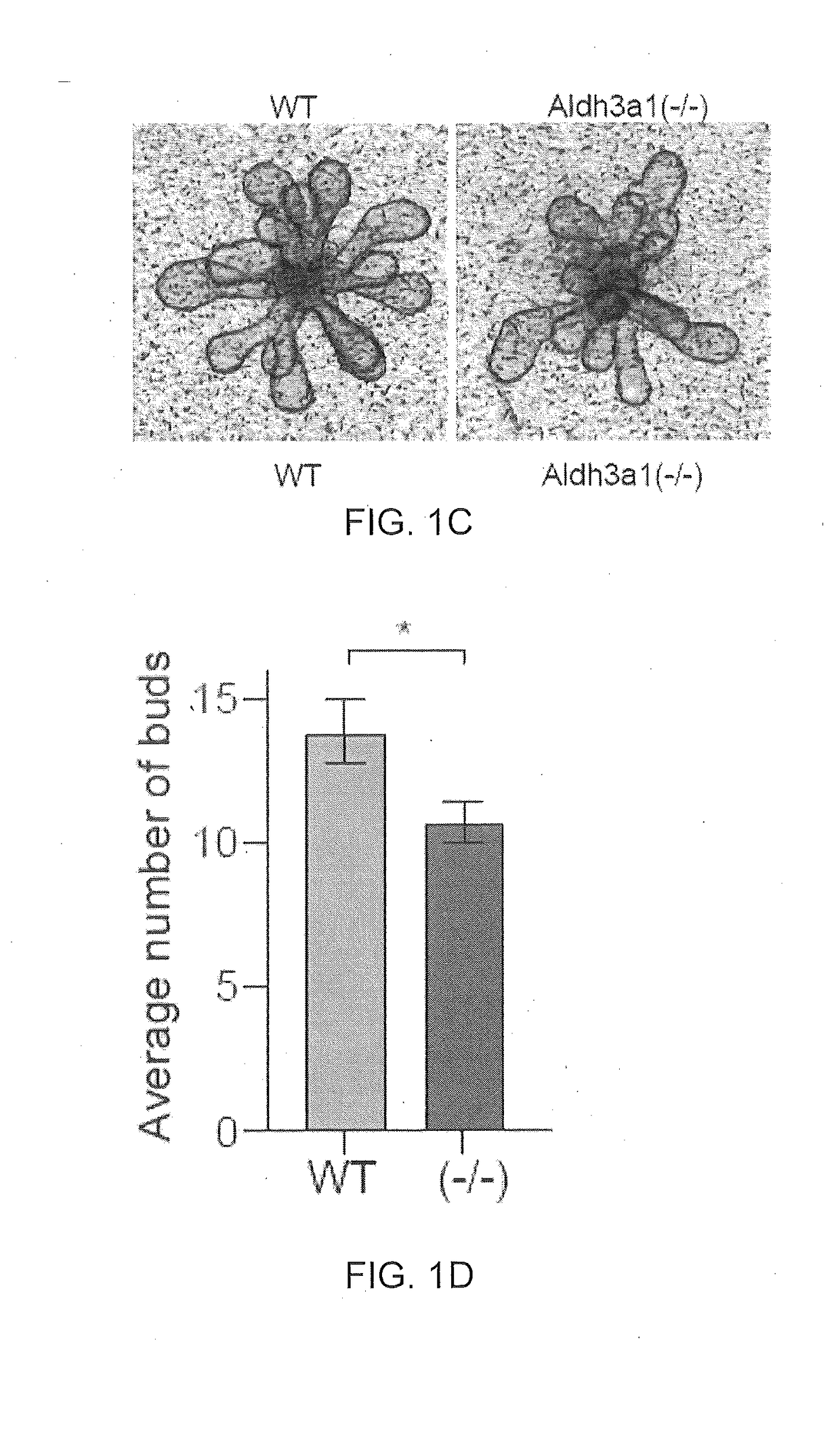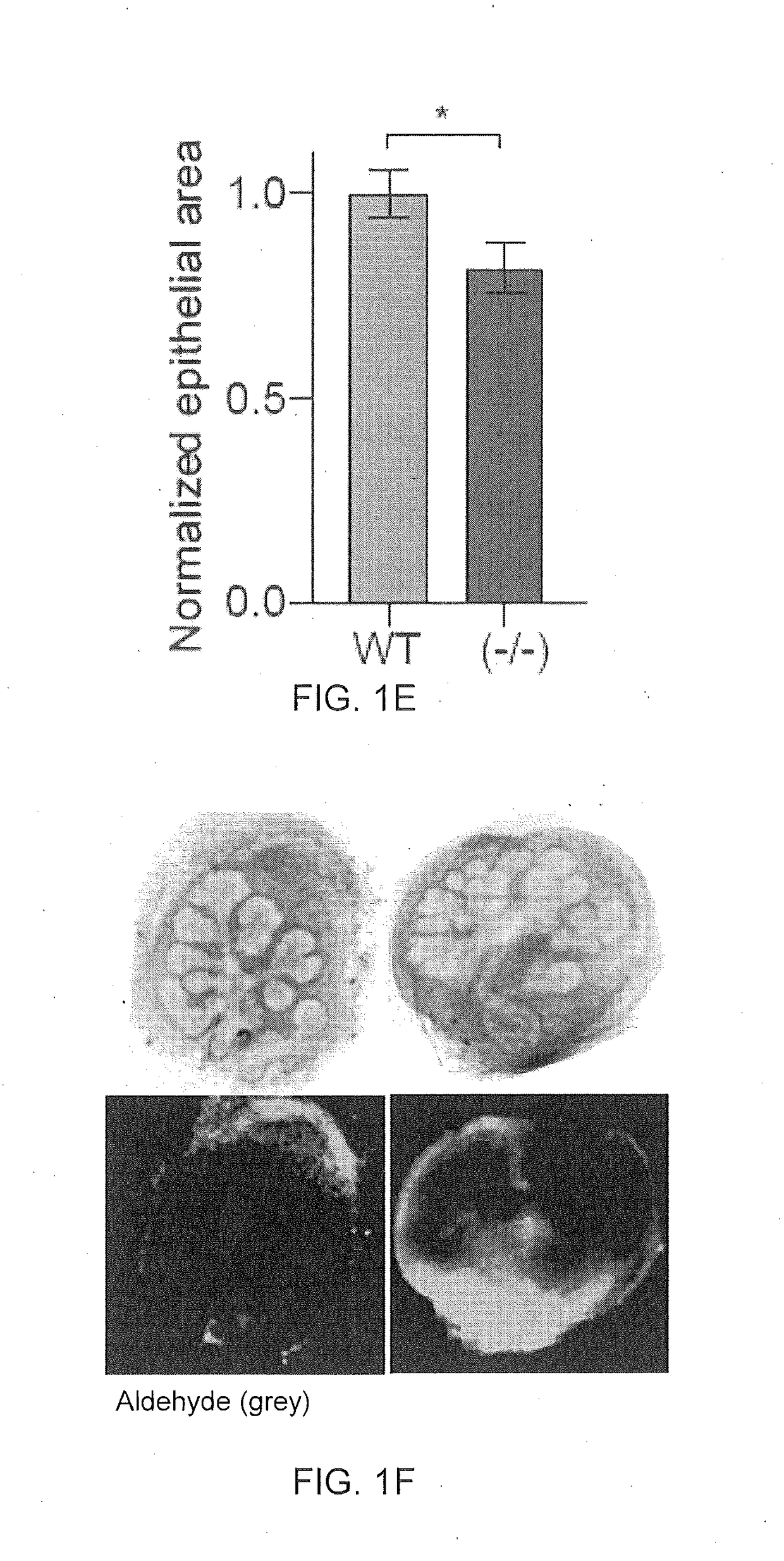Monoterpene activators of aldehyde dehydrogenase 3a1 and methods of use thereof
a technology of aldehyde dehydrogenase and monoterpene, which is applied in the field of monoterpene activators of aldehyde dehydrogenase 3a1 and its use, can solve the problems of serious health problems such as dry mouth, permanent damage to the salivary glands, and loss of function, so as to improve salivary gland function and increase the proliferation of adult salivary cells. , the effect of increasing the proliferation of adult salivary stem
- Summary
- Abstract
- Description
- Claims
- Application Information
AI Technical Summary
Benefits of technology
Problems solved by technology
Method used
Image
Examples
example 1
To Determine if Loss of ALDH3 Impairs Normal Salivary Stem / Progenitor Cell (SSPC) Function and Accelerates Hyposalivation After Radiation
[0133]To determine the role of ALDH3A1 in SSPC self-renewal, salivary sphere formation was measured of SSPC-enriched EpCAM+CD24+ cells isolated by fluorescence-activated cell sorting (FACS) from SMG of C57BL / 6 wild-type (WT) and Aldh3a1(− / −) mice.
[0134]Salisphere formation assay: Cells isolated from mouse submandibular glands (SMG) were FACS sorted using cell surface markers EpCAM and CD24 as previously described and seeded on matrigel (BD Biosciences, BD356235). Cells were grown in DMEM / F12+GlutaMax (Gibco, 10565-018) media containing 10% FBS, 1× anti-anti, 1% N2 supplement (Gibco), 20 ng / mL epidermal growth factor-2 (Sigma-Aldrich), 20 ng / mL fibroblast growth factor-2 (Sigma-Aldrich), 10 μg / mL insulin (Sigma-Aldrich), 1 μM dexamethasone (Sigma-Aldrich), 10 μM γ-27632 (Stem Cell Technologies). Spheres were passaged every 7 days by dissociating int...
example 2
Natural Product Screen to Indentify Small Molecule Activators of ALDH3
[0151]To determine if ALDH3A1 activation is sufficient to protect salivary glands from radiation-induced dysfunction, a library of 135 traditional Chinese medicine extracts donated from Sun Ten Pharmaceutical Co., Taiwan, was screened using a spectroscopic enzyme activity assay and purified recombinant ALDH3A1. At least seven extracts from this library showed an increase in ALDH3A1 activity. We then conducted high performance liquid chromatography (HPLC) fractionation of the extracts and nuclear magnetic resonance (NMR) characterization of the fractions. Based on the NMR fingerprint, we identified known constituents of similar fingerprints and purchased the commercially available compounds to test using the enzyme activity assay.
[0152]Methanol and hexane extractions of traditional Chinese medicine plants: 10 g of raw material was soaked in 100 mL of methanol or hexane overnight at 37° C. on a shaker. The mixture w...
example 3
To Determine if Activation of ALDH3 with Alda-341 Increases Normal SSPC Formation
[0163]To determine whether activation of ALDH3A1 with Alda-341 increases normal SSPC function, mouse WT EpCAM+ / CD24+-sorted cells were treated with 25 μM Alda-341 over 7 days and about a 15% increase in total salisphere number was observed compared to vehicle control (FIG. 3A).
[0164]Human salivary cells dissociated from normal salivary gland tissues that were removed surgically from patients with head and neck cancer treated with 25 μM Alda-341 also formed about 30% more salispheres than untreated cells (FIG. 3, panel B). To determine whether increased sphere formation with Alda-341 may be due in part to decreased apoptosis, 100 μM Alda-341-treated and vehicle control-treated murine WT EpCAM+ / CD24+-sorted cells were treated with Annexin V and propidium iodide and the cells were analyzed with FACS (FIG. 3C). Alda-341-treated cells demonstrated about 60% fewer early and late apoptotic cells compared to ve...
PUM
| Property | Measurement | Unit |
|---|---|---|
| Fraction | aaaaa | aaaaa |
| Time | aaaaa | aaaaa |
| Time | aaaaa | aaaaa |
Abstract
Description
Claims
Application Information
 Login to View More
Login to View More - R&D
- Intellectual Property
- Life Sciences
- Materials
- Tech Scout
- Unparalleled Data Quality
- Higher Quality Content
- 60% Fewer Hallucinations
Browse by: Latest US Patents, China's latest patents, Technical Efficacy Thesaurus, Application Domain, Technology Topic, Popular Technical Reports.
© 2025 PatSnap. All rights reserved.Legal|Privacy policy|Modern Slavery Act Transparency Statement|Sitemap|About US| Contact US: help@patsnap.com



